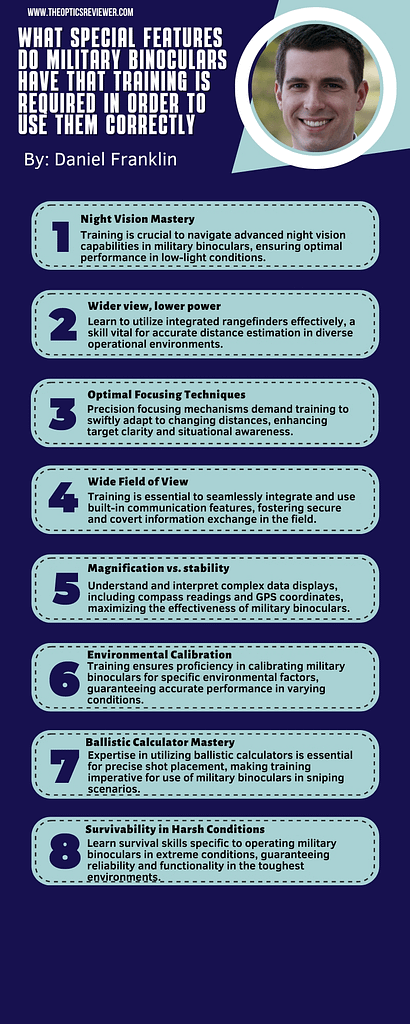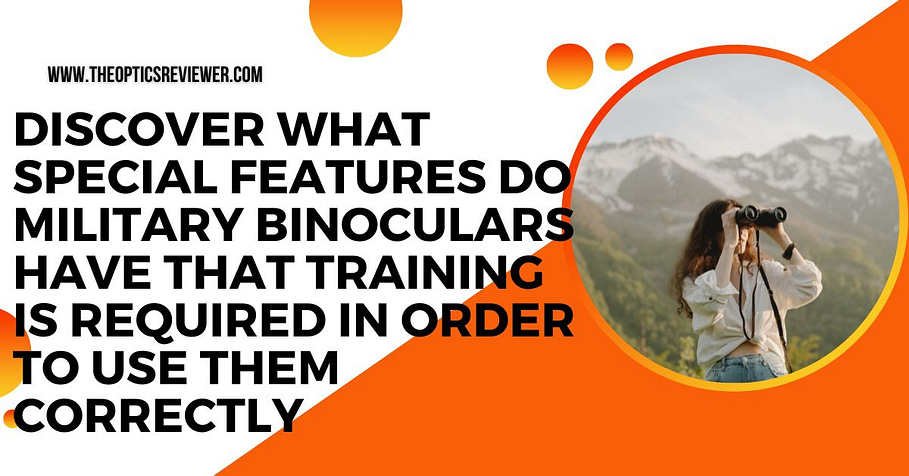Embarking on a visual journey through the lens of military binoculars unveils a world of sophistication and precision, where the extraordinary meets the tactical. What Special Features Do Military Binoculars Have That Training is Required in Order To Use Them Correctly is the intriguing question that leads us into the realm of these advanced optical instruments. Beyond the conventional, military binoculars boast cutting-edge technologies and intricate features that demand specialized training for mastery.
From range finding capabilities to night vision enhancements, these binoculars are equipped with features designed for mission-critical scenarios. Navigating the arsenal of options requires a nuanced understanding, making training essential for users to harness the full potential of these high-stakes optical tools. Join us as we unravel the secrets behind military binoculars, where expertise is the key to unlocking unparalleled vision in the field.
Contents
- 1 Key Takeaways
- 2 What are the Key Features of Military Binoculars?
- 3 What Special Features Do Military Binoculars Have That Training is Required in Order To Use Them Correctly?
- 4 What are the Special Requirements That Military Binoculars Must Meet?
- 5 What Kind of Training is Required To Use Military Binoculars Correctly?
- 6 What are the Environmental Tests That Military Binoculars Undergo Before Being Sold?
- 7 What are the Consequences of Not Following the Recommended Maintenance Procedures for Military Binoculars?
- 8 What are the Common Mistakes To Avoid When Using Military Binoculars?
- 9 Conclusion
- 10 References
- 11 FAQs
Key Takeaways
- Auto-focus binoculars offer quick and accurate focusing, eliminating the need for manual adjustments, ensuring sharp images in various viewing conditions.
- With automatic focusing technology, these binoculars are user-friendly, making them suitable for beginners and seasoned enthusiasts alike.
- The seamless auto-focus functionality allows users to effortlessly track moving subjects, ideal for birdwatching, sports events, and other dynamic activities.
- Best auto-focus binoculars provide consistent performance across different distances, ensuring clear and detailed views without the hassle of manual focusing adjustments.
What are the Key Features of Military Binoculars?
Military binoculars come with a range of key features that set them apart from standard binoculars, making them essential tools for various military applications. Some common key features of military binoculars include:
- Ruggedness and Durability: Military binoculars are built to withstand harsh conditions and rugged use, making them durable and reliable in challenging environments.
- High-Quality Optics: These binoculars often feature high-quality glass and multi-coated optics to ensure superior image clarity and brightness.
- Specialized Designs: Military binoculars may incorporate features like rangefinders, laser protection filters, mil dots, and reticles for enhanced functionality in tactical situations.
- Night Vision Capabilities: Some military binocular models are equipped with night vision technology, allowing users to see in low-light or complete darkness for specialized operations.
- Waterproof and Shockproof: Military binoculars are designed to be waterproof and shockproof, ensuring they can withstand rough handling and adverse weather conditions.
- Specialized Applications: These binoculars are used for reconnaissance, surveillance, combat, target determination, border patrol, and other military operations that require precision optics and durability.
These features make military binoculars highly specialized tools that require training to maximize their effectiveness in various military scenarios.

What Special Features Do Military Binoculars Have That Training is Required in Order To Use Them Correctly?
Military binoculars are not your ordinary pair of field glasses. Designed for precision, durability, and adaptability in combat situations, these optical instruments boast a range of special features that demand proper training to utilize effectively. Let’s explore some of these unique characteristics and why training is essential for their correct usage:
1. Advanced Optics and Magnification:
Military binoculars often feature advanced optical systems with specialized coatings and prism configurations to ensure optimal light transmission and image clarity. Additionally, they offer variable magnification settings to adapt to different viewing distances and scenarios. Training is required to understand how to adjust magnification levels properly without compromising image quality and to interpret the optical characteristics for accurate target acquisition.
2. Range finding Capabilities:
Many military-grade binoculars are equipped with built-in rangefinders to determine the distance to a target. Training is essential to learn how to operate and interpret the readings from these rangefinders accurately. This includes understanding factors that may affect range finding accuracy, such as terrain elevation, atmospheric conditions, and target size.
3. Reticle or Grid Systems:
Some military binoculars feature reticles or grid systems within the field of view to assist with target acquisition, range estimation, and navigation. Proper training is necessary to utilize these features effectively, including learning how to align the reticle with the target, estimate distances using the grid, and compensate for factors like bullet drop or windage.
4. Low Light and Night Vision Capabilities:
Military operations often occur in low-light or nighttime conditions, requiring binoculars with enhanced visibility features. Training is crucial to understand the operation of low-light and night vision modes, including adjusting settings for optimal performance, interpreting image intensifier tube characteristics, and maintaining operational security when using night vision technology.
5. Weatherproofing and Durability:
Military binoculars are built to withstand harsh environmental conditions, including extreme temperatures, moisture, and physical impact. Training is necessary to understand the limitations and capabilities of the binoculars’ weatherproofing features, as well as proper maintenance procedures to ensure long-term durability and reliability in the field.
6. Integration with Other Equipment:
Military binoculars may be designed to integrate with other equipment, such as weapon systems, communication devices, or targeting systems. Training is essential to learn how to effectively utilize these integrated features, including proper mounting and alignment procedures, interface operation, and coordination with other team members.

What are the Special Requirements That Military Binoculars Must Meet?
Military binoculars must meet stringent requirements to ensure they perform effectively in diverse and challenging operational environments. These requirements cover various aspects, including optics, durability, ergonomics, and specialized features. Here are some of the key special requirements that military binoculars must meet:
- Optical Performance:
- Clarity and Resolution: Military binoculars must provide clear and high-resolution images to facilitate accurate target identification.
- Low-Light Performance: Enhanced low-light visibility is crucial for operations during dawn, dusk, or nighttime.
- Coated Optics: Military binoculars often have coated lenses to reduce glare, improve light transmission, and enhance image contrast.
- Durability and Construction:
- Rugged Design: Military binoculars must withstand rough handling, extreme temperatures, and exposure to harsh environmental conditions.
- Waterproof and Fogproof: Binoculars need to be sealed to prevent water and moisture ingress, ensuring functionality in rainy or humid conditions.
- Shock Resistance: The construction should be robust enough to endure physical shocks and vibrations.
- Magnification and Field of View:
- Variable Magnification: Military binoculars often have adjustable magnification settings to adapt to different scenarios.
- Wide Field of View: A wide field of view is essential for maintaining situational awareness and tracking moving targets.
- Range Estimation and Targeting:
- Rangefinder: Some military binoculars incorporate rangefinding capabilities for accurate distance measurement to targets.
- Reticle/Grid System: Binoculars may feature reticles or grid systems to aid in target acquisition and range estimation.
- Night Vision Technology:
- Low-Light and Night Vision Capabilities: Military binoculars may include technology for improved visibility in low-light conditions or complete darkness.
- Ergonomics and Usability:
- Adjustable Eyepieces: Binoculars should have adjustable eyepieces to accommodate different users and ensure a comfortable fit.
- User-Friendly Controls: Controls should be intuitive and easy to operate, even in stressful situations.
- Weight and Portability:
- Lightweight Design: While durability is crucial, military binoculars should also be lightweight for ease of portability during extended use.
- Battery Life:
- Long Battery Life: If the binoculars incorporate electronic features such as rangefinders or night vision, they should have a reliable and long-lasting power source.
- Integration with Other Equipment:
- Compatibility: If binoculars are designed to integrate with other military equipment, they must be compatible and provide seamless communication.
- Security and Stealth:
- Low IR Signature: Infrared (IR) signature should be minimized to avoid detection by enemy night vision equipment.
If interested you can read more about best binoculars for wildlife viewing.
What Kind of Training is Required To Use Military Binoculars Correctly?
To use military binoculars correctly, specialized training is essential to ensure that military personnel can effectively leverage the advanced features and capabilities of these optical instruments. The training encompasses a comprehensive understanding of optics and magnification, instructing users on how to adjust and optimize magnification levels for different scenarios, interpret critical optical characteristics, and recognize the impact of environmental factors on performance. Range finding and targeting training involve operating built-in rangefinders accurately, employing reticles or grid systems for precise target acquisition, and adjusting for external factors like bullet drop or windage. Learning to operate low-light and night vision modes effectively is crucial for missions in challenging light conditions, with an emphasis on understanding technology limitations and minimizing the risk of revealing the operator’s position.
Training also covers the binoculars’ weatherproofing and durability features, teaching users how to maintain the equipment in diverse environmental conditions and adopt proper handling techniques to prevent damage. Ergonomics and adjustments training focus on individual comfort through proper eyepiece adjustment and familiarity with control placements, even in high-stress situations. Understanding how to integrate binoculars with other military equipment, such as weapons and communication devices, ensures seamless coordination in the field. Security and stealth considerations involve minimizing the infrared (IR) signature to avoid enemy detection and maintaining operational security during specialized feature usage.
Maintenance and care training include routine tasks to ensure equipment longevity, recognizing signs of wear and tear, and knowing when to seek servicing or replacement. Tactical considerations and safety protocols round out the training, emphasizing the incorporation of binoculars into mission planning and adhering to safety guidelines during operation. This multifaceted training approach ensures military personnel are proficient in utilizing military binoculars effectively across a range of operational scenarios.
What are the Environmental Tests That Military Binoculars Undergo Before Being Sold?
Before being sold, military binoculars undergo a series of rigorous environmental tests to ensure their performance and reliability in diverse operational conditions. These tests are designed to simulate the harsh environments that military personnel may encounter during missions. Temperature testing assesses the binoculars’ functionality in extreme cold and heat, ensuring they can operate seamlessly in various climates. Humidity and moisture resistance tests evaluate the binoculars’ ability to resist internal fogging and water immersion. Vibration and shock testing simulate transportation conditions and assess the binoculars’ durability against mechanical shocks.
Dust and sand resistance tests gauge the resistance to abrasive particles. Altitude testing ensures proper functionality at different elevations, and salt fog testing assesses resistance to corrosion in maritime environments. UV radiation testing evaluates the impact on materials and coatings, while fungus resistance tests assess contamination resistance. Field testing in real-world conditions and operational life testing over an extended period ensure that military binoculars meet or exceed the demanding standards set for their performance and durability. These comprehensive tests contribute to the reliability and effectiveness of military binoculars in challenging and dynamic operational scenarios.
If interested you can read more about best binoculars for yellowstone.
What are the Consequences of Not Following the Recommended Maintenance Procedures for Military Binoculars?
Failing to follow the recommended maintenance procedures for military binoculars can have various consequences, compromising the performance, longevity, and reliability of the equipment. Here are some potential consequences of neglecting proper maintenance:
- Reduced Optical Performance:
- Failure to clean and protect lenses can lead to the accumulation of dirt, dust, or moisture, affecting image clarity and reducing optical performance. This can hinder target identification and compromise the overall effectiveness of the binoculars.
- Diminished Low-Light and Night Vision Capabilities:
- Neglecting maintenance may impact the coatings on lenses designed to enhance low-light and night vision performance. This could result in decreased visibility during low-light conditions, affecting the binoculars’ utility in crucial operational scenarios.
- Compromised Waterproofing and Durability:
- Lack of proper care may lead to the deterioration of seals and gaskets, compromising the waterproofing of the binoculars. Exposure to moisture or immersion in water without adequate protection can damage internal components and reduce overall durability.
- Mechanical Failures:
- Failure to conduct routine checks and lubrication on moving parts such as focus mechanisms and diopter adjustments may lead to mechanical failures. This can impede the smooth operation of the binoculars and impact the user’s ability to quickly and accurately focus on targets.
- Corrosion and Rusting:
- Military binoculars are often used in harsh environments, and neglecting maintenance may result in corrosion and rusting of metal components. This can compromise the structural integrity of the binoculars and lead to irreversible damage.
- Battery Issues:
- If the binoculars incorporate electronic components, such as rangefinders or night vision technology, neglecting battery maintenance can result in unexpected power failures during critical moments, affecting the functionality of these features.
- Increased Risk of Malfunctions in Extreme Conditions:
- Without proper maintenance, binoculars may be more prone to malfunctions in extreme conditions, including temperature extremes, high humidity, or intense vibrations. This increases the risk of equipment failure during critical missions.
- Shortened Lifespan:
- Regular maintenance is essential for preserving the overall lifespan of military binoculars. Neglecting maintenance procedures can accelerate wear and tear, leading to premature failure and necessitating more frequent replacements.
- Compromised Tactical Advantage:
- Military personnel rely on binoculars for crucial tasks such as reconnaissance, target acquisition, and surveillance. Failure to maintain the equipment properly can compromise the tactical advantage provided by these optical instruments, impacting mission success.
If interested you can read more about how far can you see with 10×50 binoculars.
What are the Common Mistakes To Avoid When Using Military Binoculars?
- Neglecting Regular Maintenance: Failing to clean lenses, check seals, and lubricate moving parts can lead to performance degradation and equipment failure.
- Incorrect Adjustment of Optics: Incorrectly setting magnification levels, failing to focus properly, or misusing diopter adjustments can result in blurry images and reduced effectiveness.
- Ignoring Environmental Considerations: Neglecting to consider factors like temperature, humidity, and terrain can lead to suboptimal performance or damage to the binoculars.
- Not Utilizing Lens Covers: Failing to use lens covers exposes lenses to potential damage, including scratches, dust, and moisture, compromising optical quality.
- Misusing Range finding Features: Incorrectly operating built-in rangefinders can lead to inaccurate distance measurements, affecting precision in target acquisition.
- Not Securing the Binoculars Properly: Inadequately securing binoculars during movement or using them without a stable platform can result in hand shake, making it challenging to maintain a clear view.
- Forgetting to Adjust for Individual Eyes: Neglecting to customize the interpupillary distance and eyepiece adjustments can cause discomfort and hinder effective use for individual users.
- Overlooking Battery Maintenance: Ignoring the condition of batteries, especially in models with electronic features, may result in unexpected power failure during critical moments.
- Failing to Follow Safety Protocols: Disregarding safety guidelines, especially when using features like laser rangefinders, can pose risks to the user and others in the vicinity.
- Ignoring Calibration and Alignment: Neglecting proper calibration and alignment procedures, especially in models with integrated features, can lead to inaccurate readings and reduced functionality.
Conclusion
In conclusion, military binoculars are not just optical devices; they are advanced instruments equipped with specialized features that demand proper training for effective utilization. The keyword What special features do military binoculars have that training is required in order to use them correctly encapsulates the essence of these high-tech devices. From rangefinders and reticle systems to low-light capabilities and durable construction, military binoculars require skilled operators who understand how to harness these features for optimal performance.
Only through training can military personnel unlock the full potential of these binoculars, ensuring precision in target acquisition, reliable functionality in extreme conditions, and the ability to maintain a tactical edge on the battlefield. The keyword emphasizes the symbiotic relationship between cutting-edge features and the expertise derived from proper training, highlighting the significance of honing skills to navigate the complexities of military binoculars.
References
- https://core.ac.uk/download/pdf/212800020.pdf
- https://onlinelibrary.wiley.com/doi/abs/10.1111/j.1755-3768.1978.tb01375.x
- https://onlinelibrary.wiley.com/doi/abs/10.1111/j.1755-3768.1978.tb01375.x
- https://link.springer.com/article/10.1007/BF00229264
FAQs
What Does the Military Use For Binoculars?
The military uses advanced binoculars with features such as rangefinders, night vision capabilities, and rugged construction for durability, providing specialized tools for reconnaissance, surveillance, and target acquisition in various operational environments. These binoculars are designed to meet stringent standards and offer enhanced performance in the field.
What Kind of Binoculars Do They Use in the War?
In warfare, military forces commonly use specialized binoculars designed for tactical applications, featuring rugged construction, high magnification, and advanced features such as rangefinders and night vision technology for enhanced situational awareness. These binoculars are built to withstand harsh conditions and provide precise vision in diverse operational environments.
What are the Important Uses of Binoculars?
Binoculars are crucial for birdwatching, wildlife observation, and outdoor activities, providing enhanced visual clarity and detail. In military and security applications, binoculars play a vital role in reconnaissance, target acquisition, and maintaining situational awareness.
Are Military Binoculars Good?
Yes, military binoculars are designed for exceptional durability, optical performance, and specialized features, making them highly effective tools for reconnaissance and tactical operations in challenging environments. Their robust construction and advanced capabilities contribute to their reputation as reliable and indispensable equipment for military use.

